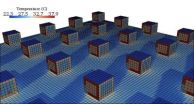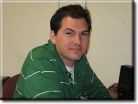(Press-News.org) A push to replace old, heat-trapping paving materials with new, cooler materials could actually lead to higher electricity bills for surrounding buildings, engineers at the University of California, San Diego, have found. Researchers published their findings Oct. 29 in the new Journal of Urban Climate.
The new paving materials are designed to lower the overall temperature of the areas where they are used—something that the study, which was focused on local solar radiation and energy consumption, was not designed to measure.
The study sounds a note of caution at a time when both federal and state legislatures have been pushing for increased use of the new highly reflective pavement materials. Assembly Bill 296, which became law in California this year, is designed to advance cool pavement practices in the state and requires the compilation of a Cool Pavement Handbook. The federal Heat Island and Smog Reduction Act of 2011, currently under consideration in Congress, would specifically require paving materials with higher solar reflectivity.
"Our findings suggested that some benefits associated with reflective pavements are tied to the environment where they're used," said Jan Kleissl, a professor of environmental engineering at the Jacobs School of Engineering at UC San Diego. "More studies are needed to determine where these new materials would be most beneficial."
The new materials could have a positive effect in areas where buildings can automatically respond to additional sunlight because they are equipped with smart lighting solutions, such as dimmers run by photo-sensitive cells.
However, buildings without these features do not fare as well. The increases in consumption of cooling energy due to the new pavements ranged anywhere from 4.5 to 9.5 percent for typical newer, and better insulated, buildings; and from 5 to 11 percent for older structures. That's because the new paving materials stay cool by reflecting significantly more of the sun's rays than traditional pavements. Many rays are reflected back into space, helping to cool surrounding areas—and the planet. However, a portion of these rays gets reflected onto the windows of nearby buildings. In the researchers' study, windows facing the reflective pavements got 40 percent more daily sunshine in summer as windows facing more traditional paving surfaces (in winter the difference was only 12 percent). That in turn increases temperatures inside the building, especially if the windows do not have solar-control coating. So the buildings' occupants turn up the air conditioning. Meanwhile, office buildings that have smart lighting or energy-conscious occupants may actually benefit from the additional sunlight by being able to reduce energy use due to artificial lighting.
The worst-case scenario is when these new cooler pavements are used in office park settings with many mid-rise buildings with large window areas. The best-case scenario would be to use the new paving materials near buildings without windows; on roads or large parking lots that are not surrounded by buildings; or in warehouse districts where structures don't have air conditioning, Kleissl said.
Kleissl and Jacobs School Ph.D. student Neda Yaghoobian looked at annual energy use related to air conditioning in both older and newer four-story buildings in Phoenix, Ariz. Yaghoobian used a complex weather and building model she developed, called the Temperature of Urban Facets Indoor-Outdoor Building Energy Simulator (TUF-IOBES). The model fills an important gap by allowing the detailed simulation of the interaction between indoor and outdoor climate. The program links indoor and outdoor energy balance dynamically by taking into account real weather conditions, indoor heat sources, building and urban material properties, composition of the building envelope (such as windows and insulation), and waste heat from air conditioning.
Yaghoobian found that, as expected, temperature for the traditional, darker pavement was up to 27 degrees Fahrenheit higher than the temperature of the newer, reflective pavement. But the walls of buildings standing near the reflective pavement were up to 4 degrees Fahrenheit warmer. Specific results varied widely depending on the buildings' make up.
Natural vs. artificial light
A watt of daylight can replace up to two watts of fluorescent lighting, depending on the lighting needs of a building. In the best-case scenario, each watt of extra daylight could reduce lighting power demand by two watts. This would also decrease the building's heat gain by one watt (net), saving another third of a watt in cooling power. Further study is needed to quantify these potential savings.
Technical background on energy simulating software
Most existing building energy models do not allow modifying outdoor ground surfaces that radiatively interact with the building. On the other hand, urban surface energy balance models in the meteorological community usually treat the buildings as hollow cubes and exclude dynamic modeling of the indoor building energy balance. A new tool was necessary and created in TUF-IOBES.
TUF-IOBES goes beyond previously available models; it is the first three-dimensional fully-coupled and computationally efficient indoor-outdoor building energy simulator. Given the complexity of solar irradiance fields in the urban canopy the surface temperature fields and energy use can be simulated more faithfully. TUF-IOBES provides unprecedented insight on urban canopy and building energy heat transfer processes. It can improve our understanding of how urban geometry and material modifications and the interaction between buildings and their surroundings and dynamic combination of all of these effects in three dimensions modify the urban energy use.
INFORMATION:
Cool pavements, warm buildings, rising electricity bills
2012-11-09
ELSE PRESS RELEASES FROM THIS DATE:
Stem cell scientists discover potential way to expand cells for use with patients
2012-11-09
(TORONTO, Canada – Nov. 8, 2012) – Canadian and Italian stem cell researchers have discovered a new "master control gene" for human blood stem cells and found that manipulating its levels could potentially create a way to expand these cells for clinical use.
The findings, published today online ahead of print in Cell Stem Cell, usher in a new paradigm for the regulation of human blood stem cells, says co-principal investigator Dr. John Dick, who holds a Canada Research Chair in Stem Cell Biology and is a Senior Scientist at University Health Network's McEwen Centre for ...
Intensive farming with a climate-friendly touch: Farming/woodland mix increases yields
2012-11-09
This press release is available in Spanish and Portuguese.
Each year, huge carbon stores are lost as a result of deforestation. In South America, around four million hectares of forest are cut down every year. As a result, international climate protection programs are planning to financially compensate farmers who preserve forests or plant new trees. Demand for land is rising, however. And growing need for food and energy crops will inevitably lead to conflicts of interest over fertile land in countries such as Brazil and Ecuador.
Thomas Knoke and Michael Weber at Technische ...
Sweet new approach discovered to help produce metal casting parts, reduce toxicity
2012-11-09
CORVALLIS, Ore. – Based on a new discovery by researchers at Oregon State University, the world's multi-billion dollar foundry industry may soon develop a sweet tooth.
This industry, that produces metal castings used in everything from water pumps and jet engines to railroad and automobile parts, dates back thousands of years to before Greek and Roman times. It was important in the advance of human civilization, but still continues to evolve.
Some modern technologies use various types of "binders" to essentially glue together sands and other materials to form sophisticated ...
Preschoolers' counting abilities relate to future math performance, researcher says
2012-11-09
COLUMBIA, Mo. – Along with reciting the days of the week and the alphabet, adults often practice reciting numbers with young children. Now, new research from the University of Missouri suggests reciting numbers is not enough to prepare children for math success in elementary school. The research indicates that counting, which requires assigning numerical values to objects in chronological order, is more important for helping preschoolers acquire math skills.
"Reciting means saying the numbers from memory in chronological order, whereas counting involves understanding ...
Ovarian cancer patients have lower mortality rates when treated at high-volume hospitals
2012-11-09
New York, NY (Nov. 8, 2012) – A study by researchers at the Herbert Irving Comprehensive Cancer Center (HICCC) at NewYork-Presbyterian/Columbia University Medical Center, recently e-published ahead of print by the Journal of Clinical Oncology, suggests that women who have surgery for ovarian cancer at high-volume hospitals have superior outcomes than similar patients at low-volume hospitals.
The improved survival rate is not dependent on a lower rate of complications following surgery, but on the treatment of the complications. In fact, patients with a complication after ...
Study shows young adults with addiction benefit from active 12 step group participation
2012-11-09
CENTER CITY, Minn. (November 8, 2012) – Young adults undergoing addiction treatment benefit from regular participation in Twelve Step-based self-help groups after discharge, according to a naturalistic study published electronically and in the journal Drug and Alcohol Dependence. The study was conducted collaboratively by the Center for Addiction Medicine at Massachusetts General Hospital and Harvard Medical School and the Butler Center for Research at Hazelden.
"Very little is known about the effects of Twelve Step attendance and involvement on outcomes for young adults. ...
Medical devices powered by the ear itself
2012-11-09
Deep in the inner ear of mammals is a natural battery — a chamber filled with ions that produces an electrical potential to drive neural signals. In today's issue of the journal Nature Biotechnology, a team of researchers from MIT, the Massachusetts Eye and Ear Infirmary (MEEI) and the Harvard-MIT Division of Health Sciences and Technology (HST) demonstrate for the first time that this battery could power implantable electronic devices without impairing hearing.
The devices could monitor biological activity in the ears of people with hearing or balance impairments, or ...
A B C -- 1 2 3, but what is good for me?
2012-11-09
Philadelphia, PA, November 8, 2012 – The National Health and Nutrition Examination Surveys revealed that over 21% of children 2 to 5 years old were considered overweight or obese. Child care settings can serve as a platform to teach children about nutrition in our fight against childhood obesity, as nearly 50% of children in the United States under age 5 are enrolled in child care. In a new study released in the November/December 2012 issue of the Journal of Nutrition Education and Behavior, training child care providers about their role in children's healthful eating ...
Antioxidants may ease PAD blood pressure increase
2012-11-09
HERSHEY, Pa. -- Low antioxidant levels contribute to increased blood pressure during exercise for people with peripheral arterial disease, according to researchers at Penn State Hershey Heart and Vascular Institute.
Peripheral arterial disease, or PAD, affects an estimated 10 million Americans and increases the chance of death from a cardiovascular event. Reduced blood flow causes pain in the legs and increases blood pressure in people who have PAD. However, the causes of the disease are unknown.
"Past studies have shown that having low antioxidant levels and increased ...
Comet collisions every 6 seconds explain 17-year-old stellar mystery
2012-11-09
Every six seconds, for millions of years, comets have been colliding with one another near a star in the constellation Cetus called 49 CETI, which is visible to the naked eye.
Over the past three decades, astronomers have discovered hundreds of dusty disks around stars, but only two — 49 CETI is one — have been found that also have large amounts of gas orbiting them.
Young stars, about a million years old, have a disk of both dust and gas orbiting them, but the gas tends to dissipate within a few million years and almost always within about 10 million years. Yet ...


